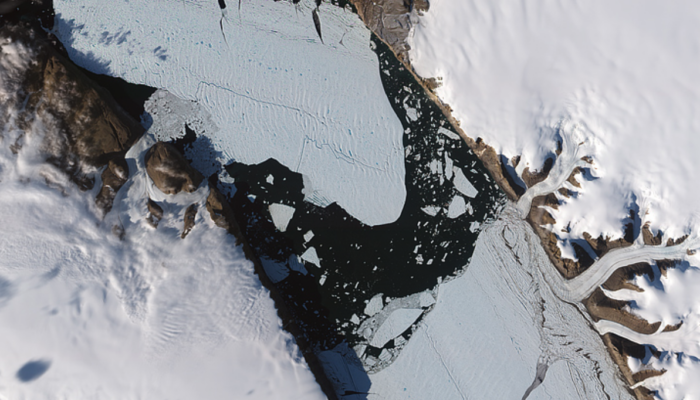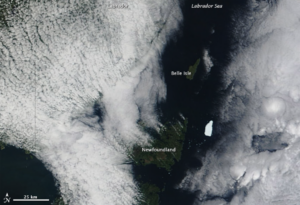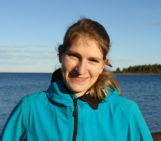
Thirteen years ago, a roughly 251 km2 chunk of ice (or 97 miles2) broke off Greenland’s Petermann Glacier. This Amsterdam-sized piece of ice was the largest to calve in the Arctic since 1962. The massive iceberg traversed the Nares Strait, which lies between Canada’s Ellesmere Island and Greenland, and into the northern part of Baffin Bay—the northwestern-most arm of the Atlantic Ocean, before eventually disintegrating.
To understand the significance of this event, the current status of Petermann Glacier, and what might happen in the future, I spoke to glaciologist Romain Millan, who is a researcher at the Institut des Geosciences de l’Environnement in Grenoble, where he uses satellite and airborne remote sensing data to better resolve inputs of freshwater into the ocean from basal melting and calving of ice shelves. Millan has worked on glaciers around the globe, and has published several papers, including one in EGU’s The Cryosphere, about Petermann Glacier.
Can you set the stage by telling us a bit about Petermann Glacier?
Petermann is one of the major glaciers of the Greenland ice sheet. It is located in North Greenland, and is one of the few glaciers that terminates in the ocean with a floating extension, that we call an ice shelf. The ice shelf of Petermann is massive, with a width at the ice front of more than 20 kilometres, and a length that has changed—between 50 and 80 kilometres.
What led to the 2010 calving event?
In July 2010, there was a large, prominent rift that formed and rapidly propagated across the ice shelf about 20 kilometres from the ice front. In August, the first piece broke off, removing 20% of the ice shelf area.
Why was the 2010 calving event so significant?
This calving event represented a loss of 10% of the total ice shelf volume of Petermann. Large calving events have the potential to reduce the buttressing effect of ice shelves, which may trigger an increase in Petermann’s ice discharge into the ocean, which would result in a greater rise in sea level.

In 2010, a huge chunk of Petermann Glacier’s ice sheet calved, forming an iceberg that floated south. About a year later, NASA’s Terra satellite’s MODIS instrument captured an image of Petermann Ice Island-A, one of the the remnants of the initial iceberg, near Newfoundland.Credit: NASA image courtesy Jeff Schmaltz, MODIS Rapid Response, NASA Goddard Space Flight Center, via NASA Earth Observatory
What happened after the 2010 event?
In 2008, another large rift formed further upstream from where the 2010 rift eventually formed. This rift was much slower to propagate, and finally led to another calving event in July 2012, which was about 1/3rd of the size of the prior one. Since 2012, the front has remained stable and has even re-advanced in 2020, recovering its original position!
Are there any new recent cracks?
Cracks regularly form on ice shelves as part of the calving process. Another larger crevasse opened in 2019, relatively close to the ice front. This fracture has widened to become a large rift that has now propagated through more than half the width of the ice shelf. So, we should expect a large calving event coming from Petermann soon. This crack is located relatively near the 2010 calving event, which could also suggest some kind of natural cycle in the calving of Petermann.
What else is happening at the glacier front?
The glacier front re-advanced in 2020, but the glacier has been thinning dramatically. A recent study has also shown that submarine melt rates in the vicinity of the grounding line are incredibly high, reaching up to 80 meters per year, which rivals the highest basal melting rates in Antarctica (like Pine Island Glacier). The grounding line is the location where the glacier starts to float—where the ice shelf begins. It is a key indicator of the dynamic stability of these glaciers.

This composite of a section of northeast Greenland’s coast includes three images, which were collected on February 15, March 10, and April 3 of 2016. The leftmost white part of the image shows Greenland’s ice sheet. In the center, slightly to the left, the Zachariæ Isstrøm Glacier flows eastward, and is dark grey. The remaining shades of grey on the left side show mostly land. The colors on the right show changes in sea-ice type between the three images.
Credit: Contains modified Copernicus Sentinel data (2016), processed by ESA, CC BY-SA 3.0 IGO
Can you explain in more detail how melting under the grounding line influences calving events?
Basal melting under ice shelves is caused by the intrusion of warm ocean water, and can be enhanced by the release of freshwater at the glacier’s grounding line. This process is weakening the ice shelf from below, making it thinner. Another consequences of increased basal melting rates is retreat of the grounding line, which causes an increase in glacier flow that can increases iceberg calving rates. If you have a thinner ice shelf that’s flowing faster, it will more easily crack, producing more calving events. Click here for a video animation of glacier grounding lines (Credit: Hannes Konrad et al, University of Leeds)
You’ve done a fair bit of research about grounding line retreat at Petermann Glacier. Can you talk about your findings?
We have shown that after 2015, the grounding line of Petermann started to retreat dramatically—up to 7 kilometres in the central section. This is far above the natural fluctuation of the grounding line, which is typically few hundreds of meters for this ice shelf. Interestingly, when the grounding line started to retreat, we also observed the formation of large cracks all along the ice shelf, which started to widen during the subsequent years. This has significantly affected the dynamics of the glacier.
How does what’s happening at Petermann Glacier fit into the rest of Greenland’s ice shelves?
The glaciers located in both the north and northeastern parts of Greenland reacted relatively recently to climate change, compared to the northwestern and southeastern parts of the ice sheet, which were already unstable in the 1980s and early 1990s. The first sign of mass losses in the northern Greenland region appeared with the collapse of the ice shelf of Zachariæ Isstrøm around 2002-2003. This glacier has almost doubled its ice discharge since then. On the other hand, Petermann had remained relatively until 2015, when we started to observe this large retreat of the grounding line.
What does all this mean for sea level rise?
Petermann Glacier is one of the largest glaciers of the Greenland ice sheet, with enough ice to raise the sea level by 38 centimetres, should it melt completely. Monitoring the evolution of this glacier, and of its ice shelf, is therefore crucial for tracking and predicting Greenland’s contribution to sea level rise. We also have some important glaciers along Greenland’s northern coast, for example 79N, where we see some ongoing signs of ice shelf weakening. If these glaciers become unstable, then Greenland’s northern glaciers could become its largest contributors to sea level rise.




